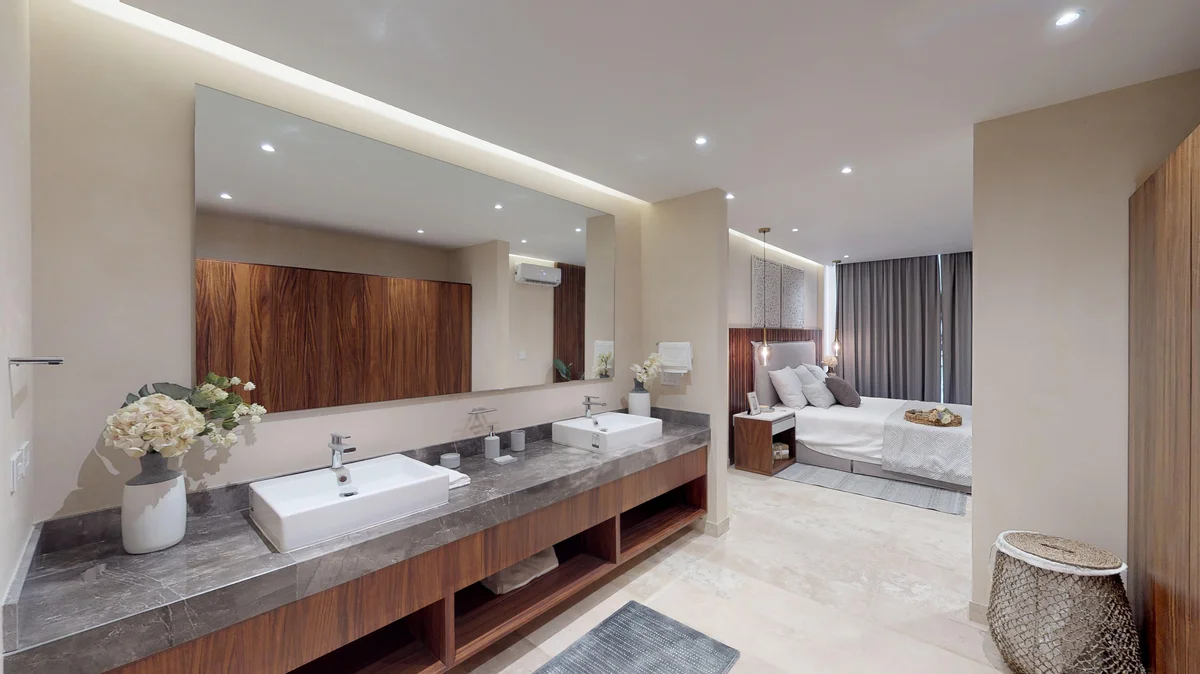A Strategic Opportunity in a Corrected Market: Acquiring a Differentiated Asset in Tulum's Luxury Sector
This investment presents a strategic entry point into the Tulum real estate market at a moment of significant dislocation. The core thesis is to acquire a lifestyle-focused asset, Mirak, at a substantial discount to potential future value, navigating a market defined by a
40% drop in demand
and a severe oversupply of condominium inventory. This environment, characterized by plummeting rental yields and distressed assets, creates a rare opportunity for a specific class of long-term capital. Despite the systemic market crash, this asset has demonstrated notable resilience, achieving a
77% sold-out status
, which signals a strong product-market fit that distinguishes it from the commoditized inventory currently overwhelming the market. The strategy requires accepting near-term negative or neutral cash flow in exchange for a high-conviction hold positioned for recovery.
🛡️ Foundational Market Strengths (Beta)
While the current market is in a deep correction, the asset is underpinned by long-term, structural catalysts that are expected to drive the eventual recovery and future appreciation of Tulum as a world-class destination. These foundational drivers provide a baseline of long-term value independent of the asset's specific attributes.
-
Strategic Infrastructure Completion:
The recent inauguration of the Tulum International Airport and the operational status of the Tren Maya rail network are transformative infrastructure projects. These developments fundamentally enhance regional accessibility and are poised to drive a new cycle of tourist and investor demand once market sentiment stabilizes.
-
Enhanced Urban Livability:
The conclusion of the 2022 PACTUM 32-month mobility plan has delivered tangible improvements to city infrastructure, including new sidewalks and an extensive network of cycle paths. While specific investment figures for the PACTUM plan were not itemized in the provided data, its completion has qualitatively improved the urban core, adding long-term value for residents and visitors.
-
Enduring Brand Equity:
Despite cyclical downturns, Tulum's global brand as a premier wellness and tourism destination remains a powerful, long-term demand anchor. Market intelligence confirms that the luxury and eco-niche sectors, which this asset targets, have demonstrated greater resilience compared to the broader market.
💎 Competitive Advantages (Alpha)
In a saturated and distressed market, the asset's specific characteristics provide a competitive moat, enabling it to attract a discerning segment of the buyer pool. These alpha drivers are critical differentiators that justify its outperformance and form the basis of the long-term recovery thesis.
-
Proven Market Absorption:
In a market environment where city-wide demand has collapsed by
40%
, the project has achieved a
77% sold-out status
on its 13 units. This sales velocity is a critical de-risking factor, providing empirical evidence that the asset's design, amenity package, and pricing resonate with the current buyer pool despite macroeconomic headwinds.
-
Differentiated Social Amenities:
The inclusion of a Teppanyaki grill and a dedicated Service Bar provides a unique, in-house social and culinary experience. This differentiates the property from competitors offering generic lounge areas and aligns with the resilient luxury segment that, according to market data, continues to attract premium value for superior amenities.
-
Hospitality-Level Service Layer:
The presence of a service bar indicates a managed, hospitality-level service proposition. In a commoditized rental market where yields have plummeted, this feature allows the asset to command higher perceived value and target a more sophisticated tenant or owner seeking a premium, managed living experience.
📈 Strategic Outlook & Risk Analysis
-
🔴 Primary Market Risk:
A critical oversupply of condominium inventory, evidenced by a reported 40% drop in demand, which has crashed the short-term rental market and led to plummeting yields.
-
🔴 Inventory Exposure:
High. The asset's inventory consists solely of condominiums, the most oversupplied and distressed segment in the current market, facing intense competition for both rentals and resale.
-
🟢 Strategic Confidence:
The analyst's confidence is rated as
Low. The lifestyle-oriented alpha drivers are insufficient to meaningfully counteract the systemic market risk of a 40% drop in demand and a severe oversupply of the asset's specific inventory type (condominiums).
-
🟢 Core Rationale:
In a market experiencing a deep correction driven by a 40% drop in demand, the strategy is to acquire this lifestyle-focused asset at a significant discount, betting that its differentiated social amenities will capture a niche segment of long-term tenants and buyers once the market eventually stabilizes, accepting near-term negative or neutral cash flow.
🎯 Ideal Investor Profile
This opportunity is exclusively suited for an opportunistic, long-term cash buyer with a high tolerance for risk and a
7-10 year
investment horizon. The ideal investor is not dependent on immediate or near-term rental income and is acquiring the asset based on a high-conviction thesis of long-term market recovery. Given the projected slowdown in the U.S. economy to
1.6% GDP growth
in 2025, this investor must be well-capitalized and insulated from the macroeconomic headwinds affecting Tulum's primary buyer pool. The profile is that of an end-user seeking a lifestyle asset for partial personal use or a patient investor who values the asset's curated amenities over acquiring a generic, more deeply distressed unit, and is willing to hold through the current cycle to realize its potential value.









